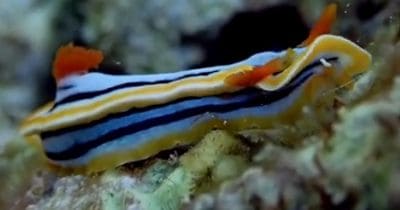Home › Ocean › Marine › Invertebrate › Mollusk › Nudibranch › Chromodoris Annae
Fun Facts about Anna's Magnificent Sea Slug
[Phylum: Mollusca] [Class: Gastropoda] [Order: Nudibranchia] [Family: Chromodorididae]
It is often mistaken for similar blue and yellow Chromodoris species, but the punctate blue mantle, and thin white margin, help to identify these magnificent sea slugs.
This page contains a collection of interesting facts about Chromodoris annae, including where they live, what they eat, and how these dorid nudibranchs reproduce.
Chromodoris Annae Habitat and Distribution
It is one of the benthic nudibranch species that populates best in warm tropical water.
Anna's magnificent sea slug is a common sighting in the central regions of the Indo-Pacific, and in particular:
- Australia (northern coastlines)
- Micronesia
- Central Pacific Ocean (the coral atolls of the Marshall Islands)
- Southeast Asia (e.g., Indonesia, Malaysia, the Philippines)
These colourful nudibranchs are most often seen around coral reefs and rocky substrates, especially where there are patches of open sand and rubble, usually at depths ranging between fifteen (15) and thirty (30) metres.
Chromodoris Annae Characteristics
The nudibranch phylum is known for bright colours and body markings. Anna's magnificent sea slug has a striking blue dorsal mantle with a punctuate pattern of fine, sometimes speckled, darker blue lines.
They also have a black longitudinal central line that runs from head to the gills, and a narrow white marginal band that creates an outline at the rim of the skirt-like mantle.
In fact, the mantle partially covers the yellowish orange foot, but the bright orange sensory organs (rhinophores), and gill plumes, are distinctly visible.
But wait - there's more:
A general elongated shape and smooth mantle is typical of dorid nudibranchs. When disturbed, they are capable of retracting the posterior circle of gills.
They are slow-moving creatures that wander around alone, or in pairs. Nonetheless, the aposematic definition acts as a warning of toxic compounds sequestered from their primary diet - sea sponges.
Even though they show some resemblance to similar blue Chromodoris species, especially Elisabeth's chromodoris, Anna's magnificent sea slug rarely grows much bigger than five (5) centimetres long.
What Do Chromodoris Nudibranchs Eat?
Most nudibranchia are carnivores that create their impressive bright colouration by storing chemicals from the food that they eat.
In the wild, Chromodoris annae is a specialised sponge-feeder. They have particular associations with certain types of sea sponges (e.g., chemically rich blue-grey demosponges like Petrosaspongia).
 They use a toothed, ribbon-like structure (called a radula) to scrape away substrates. In some species, the diet may also include:
They use a toothed, ribbon-like structure (called a radula) to scrape away substrates. In some species, the diet may also include:
- Anemones
- Coral polyps
- Hydroids
- Other sea slugs
- Tunicate sea squirts
Fun Fact: Some species of nudibranch are picky eaters, often only feeding on specific food types or even a single source of prey.
Chromodoris Annae Reproduction
The fact that nudibranchs are simultaneous hermaphrodites means that each individual possesses male and female reproductive sex organs.
In general, when two adults mate they exchange sperm so that each partner is capable of laying eggs afterward.
The mating posture occurs with an alignment of the right sides of the body. This is the location of the reproductive openings, which allows for the extension of a copulatory organ used for exchanging sperm.
Here's the thing:
After the mating ritual has finished, each slug will lay a ribbon-like mass of coiled or wavy eggs, often thousands of eggs per clutch. They usually attach the microscopic eggs to a hard substrate, such as coral, sponge, or rocks.
Because parental care is absent, the eggs hatch into planktonic veliger larvae and drift with planktonic organisms in the water column, before eventually settling to metamorphose into juvenile nudibranchs.
Chromodoris Predators and Threats
Anna's magnificent sea slug (Chromodoris annae) only has a few natural predators because they can store potent chemical compounds from sponges (especially latrunculin-type toxins). So, even though most reef predators avoid them, predation may occur from:
- Specialised reef fish that tolerate nudibranch toxins, such as pufferfish and wrasses.
- Crabs (some species of opportunistic benthic predators like to eat sea slug egg ribbons).
- Carnivorous nudibranchs (scientists believe that cannibalism may occur in some species).
Nudibranchs have relatively low densities and specific dietary needs, especially when kept in captivity. Although a minor issue globally, the over-collection of nudibranch for fish tanks can impact small localised populations. Other human-influenced threats also include:
- A reduction in coral reef formations from coral whitening, destructive fishing practices, as well as coastal development.
- Sedimentation and other kinds of pollution in the ocean decreases water quality and causes severe harm to most sea sponge species (Spongiidae).
- Warmer waters are altering sponge communities and ocean acidification also affects larval development in nudibranchs and sea slugs.
Interesting Fact: Sea slugs have become extremely important to the development of some medications. In fact, scientists are actively studying nudibranch anatomy, especially how the nervous system works, as part of further research.